I want to project an image from spherical to cubemap. From what I understood studying maths, I need to create a theta, phi distribution for each pixel and then convert it into cartesian system to get a normalized pixel map.
I used the following code to do so
theta = 0
phi = np.pi/2
squareLength = 2048
# theta phi distribution for X-positive face
t = np.linspace(theta + np.pi/4, theta - np.pi/4, squareLength)
p = np.linspace(phi + np.pi/4, phi - np.pi/4, squareLength)
x, y = np.meshgrid(t, p)
# converting into cartesion sytem for X-positive face (where r is the distance from sphere center to cube plane and X is constantly 0.5 in cartesian system)
X = np.zeros_like(y)
X[:,:] = 0.5
r = X / (np.cos(x) * np.sin(y))
Y = r * np.sin(x) * np.sin(y)
Z = r * np.cos(y)
XYZ = np.stack((X, Y, Z), axis=2)
# shifting pixels from the negative side
XYZ = XYZ + [0, 0.5, 0.5]
# since i want to project on X-positive face my map should be
x_map = -XYZ[:, :, 1] * squareLength
y_map = XYZ[:,:, 2] * squareLength
The above map created should give me my desired result with cv2.remap() but it's not. Then I tried looping through pixels and implement my own remap without interpolation or extrapolation. With some hit and trial, I deduced the following formula which gives me the correct result
for i in range(2048):
for j in range(2048):
try:
image[int(y_map[i,j]), int(x_map[i,j])] = im[i, j]
except:
pass
which is reverse of actual cv2 remapping which says dst(x,y)=src(mapx(x,y),mapy(x,y))
I do not understand if did the math all wrong or is there a way to covert x_map and y_map to correct forms so that cv2.remap() gives the desired result.
DESIRED RESULT (this one is without interpolation using loops)



